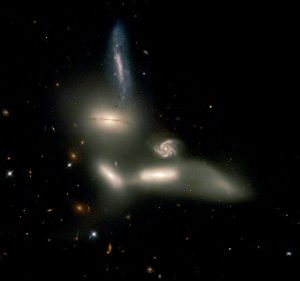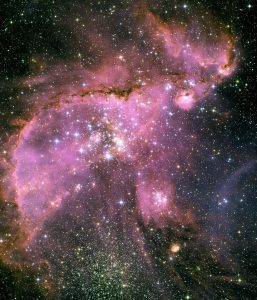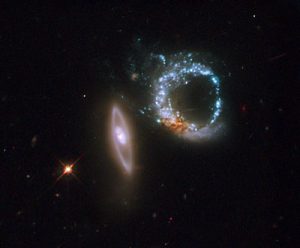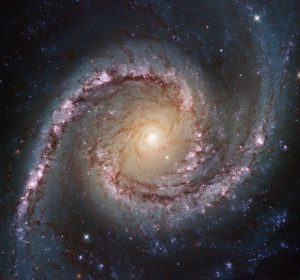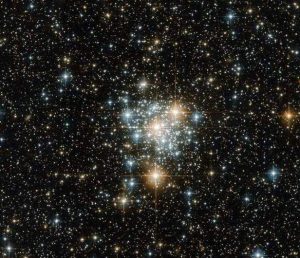telescopio Hubble
Caotico scintillio di stelle
Questa immagine del telescopio Hubble mostra NGC 4789A, una galassia nana irregolare nella costellazione della Chioma di Berenice. Sicuramente la galassia merita l’appartenenza alla sua classe, dal momento che le stelle sembrano pietre preziose sparse nel cosmo in una sorta di disordine apparente, fornendo a NGC 4789A un aspetto molto più discreto e caotico rispetto alle sue maestose compagne ellittiche e a spirale. Continua a leggere
Le Galassie Antenne
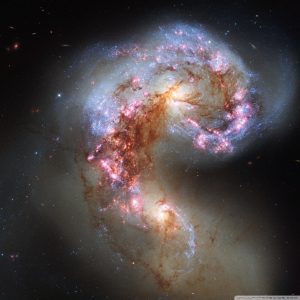 Le Galassie Antenne, note anche come NGC 4038 e NGC 4039, sono bloccate in un abbraccio mortale. La coppia ha trascorso alcune centinaia di milioni di anni a interagire violentemente, pur essendo un tempo normali, tranquille galassie a spirale. Questo scontro è stato così devastante che le stelle sono state strappate via dalle loro galassie ospiti così da formare un arco che scorre tra le due. Continua a leggere
Le Galassie Antenne, note anche come NGC 4038 e NGC 4039, sono bloccate in un abbraccio mortale. La coppia ha trascorso alcune centinaia di milioni di anni a interagire violentemente, pur essendo un tempo normali, tranquille galassie a spirale. Questo scontro è stato così devastante che le stelle sono state strappate via dalle loro galassie ospiti così da formare un arco che scorre tra le due. Continua a leggere
Danza Cosmica di Distruzione
In questa immagine del telescopio Hubble un gruppo di galassie è impegnato in una lenta danza di distruzione che durerà per miliardi di anni. Le galassie sono così strettamente accorpate che le forze gravitazionali stanno strappando via da loro le stelle e ne distorcono le forme. L’azione della gravità alla fine potrebbe riunire insieme le galassie fino a formare un’unica grande galassia. Continua a leggere
Giovani stelle creano sculture artistiche
Questa spettacolare immagine ripresa dal telescopio spaziale Hubble rivela i dettagli di una delle regioni di formazione stellare più dinamiche e complesse nello spazio, a 210.000 anni luce di distanza nella Piccola Nube di Magellano, una galassia nelle vicinanze della Via Lattea. Continua a leggere
Una stella neonata arde nel firmamento
I filamenti perlacei che circondano la stella IRAS 10082-5647 in questa mirabile immagine del telescopio Hubble attirano sicuramente lo sguardo. La nube fumosa è una nebulosa a riflessione, formata da gas e polveri, che brilla delicatamente per la luce riflessa di stelle nelle vicinanze, in questo caso una stella Ae/Be di Herbig estremamente giovane. Continua a leggere
Un bel dieci per Hubble
Questa incredibile coppia di galassie interagenti viene chiamata Arp 147, e questa volta, come molte altre, Hubble si merita un bel 10 in termini di bellezza. Continua a leggere
Una coppia magnifica
Davvero spettacolare l’abbinamento tra la stella Hen 2-427, conosciuta più comunemente come WR 124, e la nebulosa M1-67 che la circonda. Entrambi gli oggetti, ripresi dal telescopio Hubble, si trovano nella costellazione del Sagittario, a circa 15.000 anni luce di distanza. Continua a leggere
Come un Girasole
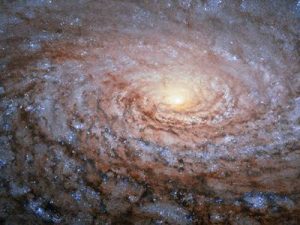 La disposizione dei bracci di spirale della galassia Messier 63, visibile in questa immagine ripresa dal telescopio Hubble, richiama alla mente la struttura nel centro di un girasole per il gran numero di segmenti di spirale che circondano il nucleo, pervasi da nubi di polvere interstellare Continua a leggere
La disposizione dei bracci di spirale della galassia Messier 63, visibile in questa immagine ripresa dal telescopio Hubble, richiama alla mente la struttura nel centro di un girasole per il gran numero di segmenti di spirale che circondano il nucleo, pervasi da nubi di polvere interstellare Continua a leggere
Vortici Maestosi da Hubble
Questa immagine mozzafiato ripresa dal telescopio Hubble mostra NGC 1566, una splendida galassia situata a circa 40 milioni di anni luce di distanza nella costellazione del Dorado. NGC 1566 è una galassia a spirale intermedia: anche se non ha una regione di stelle ben definita a forma di barra al suo centro, come le spirali barrate, non è nemmeno una spirale non barrata. Continua a leggere
Uno Scrigno di Gioielli nel Tucano
Anche se potrebbe essere già famosa per ospitare oggetti spettacolari come la galassia nana del Tucano e 47 Tucanae, il secondo ammasso globulare più brillante nel cielo notturno, la costellazione australe del Tucano possiede una varietà di bellezze cosmiche poco conosciute. Uno di questi gioielli è NGC 299, un ammasso stellare aperto localizzato all’interno della Piccola Nube di Magellano a circa 200.000 anni luce di distanza. Continua a leggere

